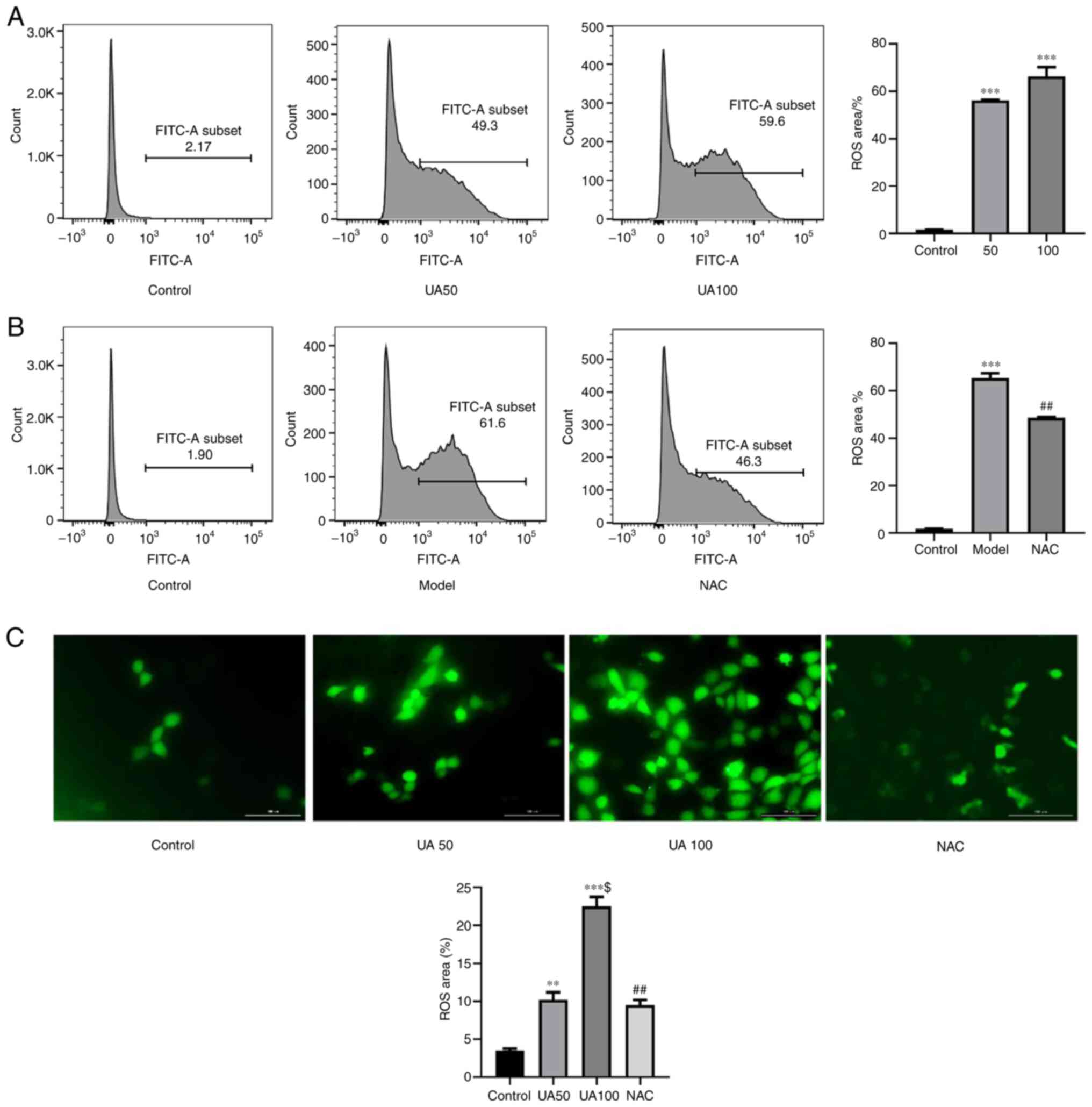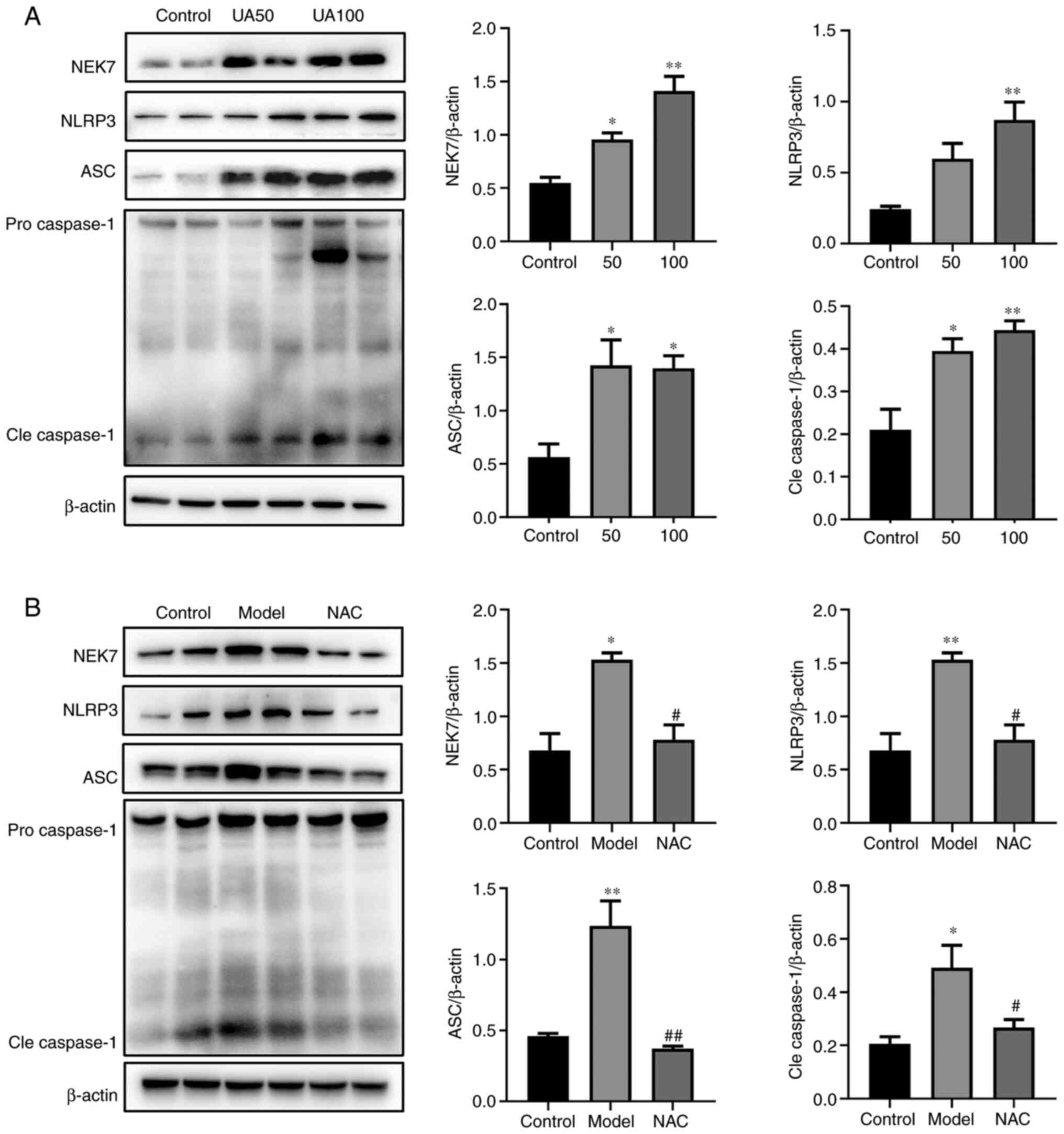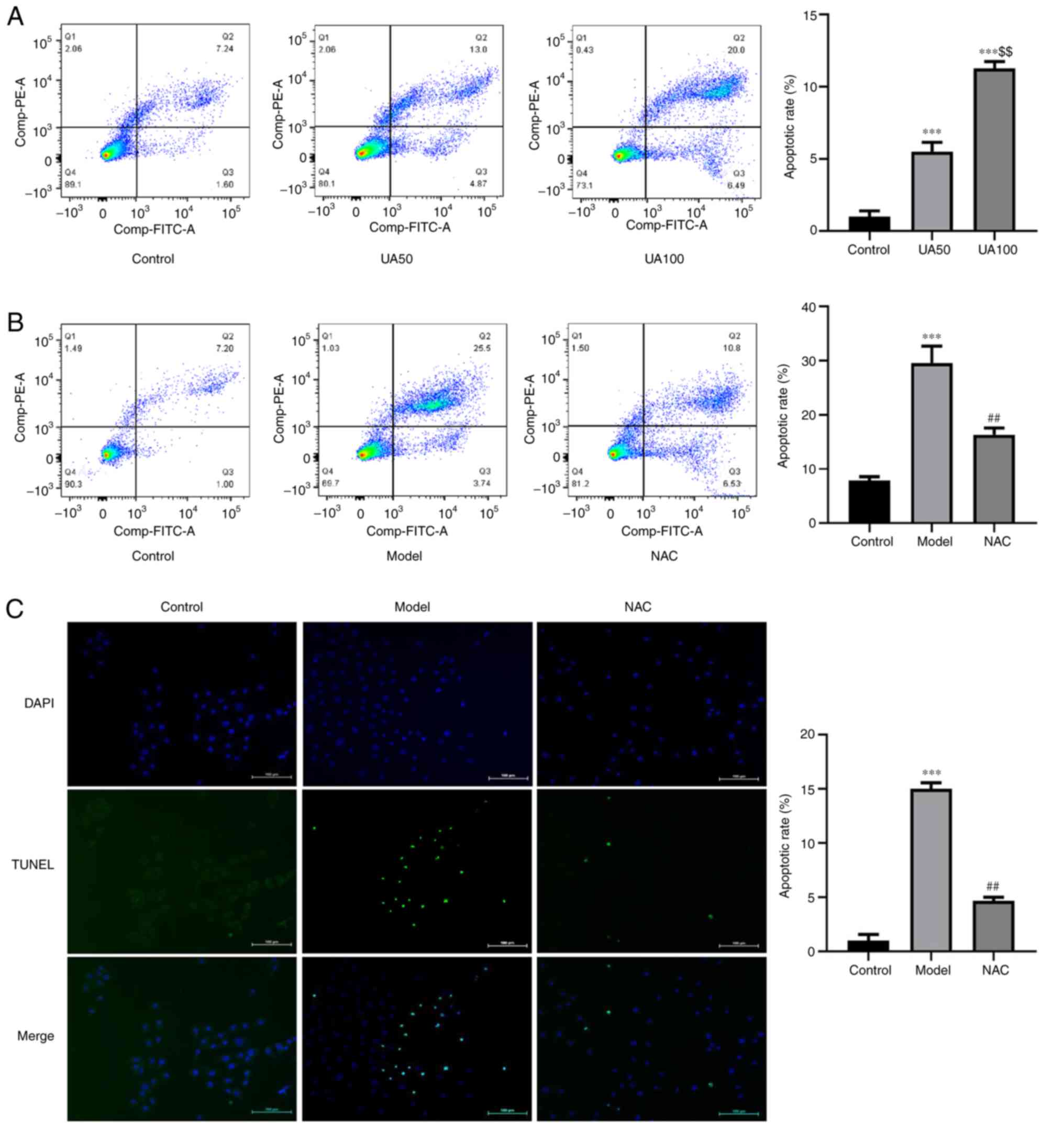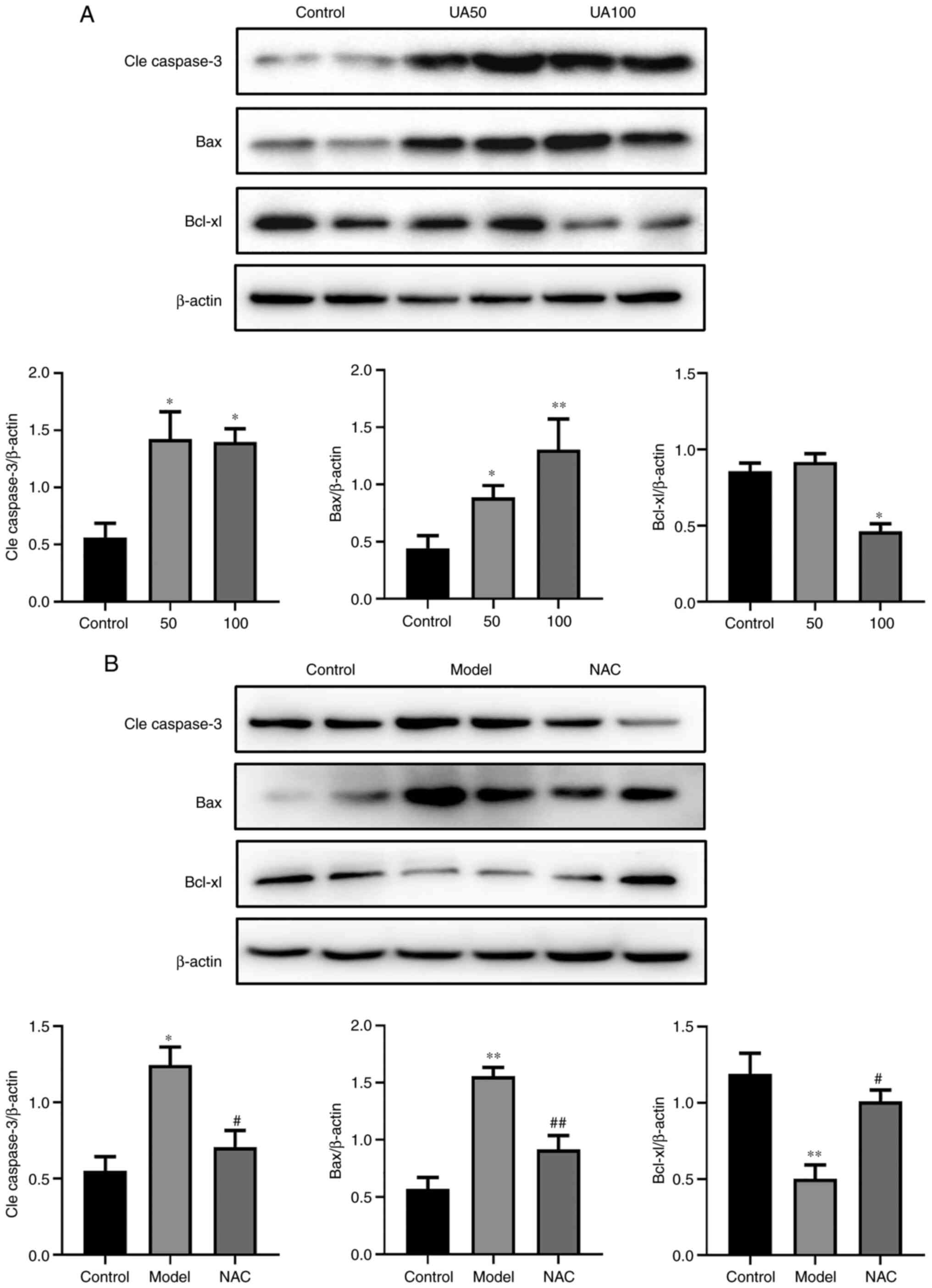|
1
|
He L, Fan Y, Xiao W, Chen T, Wen J, Dong
Y, Wang Y, Li S, Xue R, Zheng L, et al: Febuxostat attenuates ER
stress mediated kidney injury in a rat model of hyperuricemic
nephropathy. Oncotarget. 8:111295–111308. 2017. View Article : Google Scholar : PubMed/NCBI
|
|
2
|
Kang DH: Hyperuricemia and progression of
chronic kidney disease: Role of phenotype transition of renal
tubular and endothelial cells. Contrib Nephrol. 192:48–55. 2018.
View Article : Google Scholar : PubMed/NCBI
|
|
3
|
Tao M, Shi Y, Tang L, Wang Y, Fang L,
Jiang W, Lin T, Qiu A, Zhuang S and Liu N: Blockade of ERK1/2 by
U0126 alleviates uric acid-induced EMT and tubular cell injury in
rats with hyperuricemic nephropathy. Am J Physiol Renal Physiol.
316:F660–F673. 2019. View Article : Google Scholar : PubMed/NCBI
|
|
4
|
Priante G, Gianesello L, Ceol M, Del Prete
D and Anglani F: Cell death in the kidney. Int J Mol Sci.
20:35982019. View Article : Google Scholar : PubMed/NCBI
|
|
5
|
Yin W, Zhou QL, OuYang SX, Chen Y, Gong YT
and Liang YM: Uric acid regulates NLRP3/IL-1β signaling pathway and
further induces vascular endothelial cells injury in early CKD
through ROS activation and K+ efflux. BMC Nephrol.
20:3192019. View Article : Google Scholar : PubMed/NCBI
|
|
6
|
Moreno-Irusta A, Dominguez EM,
Marín-Briggiler CI, Matamoros-Volante A, Lucchesi O, Tomes CN,
Treviño CL, Mariano GB, Lascano R, Losinno L and Giojalas LC:
Reactive oxygen species are involved in the signaling of equine
sperm chemotaxis. Reproduction. 159:423–436. 2020. View Article : Google Scholar : PubMed/NCBI
|
|
7
|
Liu G, Chen X, Wang Q and Yuan L: NEK7: A
potential therapy target for NLRP3-related diseases. Biosci Trends.
14:74–82. 2020. View Article : Google Scholar : PubMed/NCBI
|
|
8
|
Shi H, Wang Y, Li X, Zhan X, Tang M, Fina
M, Su L, Pratt D, Bu CH, Hildebrand S, et al: NLRP3 activation and
mitosis are mutually exclusive events coordinated by NEK7, a new
inflammasome component. Nat Immunol. 17:250–258. 2016. View Article : Google Scholar : PubMed/NCBI
|
|
9
|
Ma ZZ, Sun HS, Lv JC, Guo L and Yang QR:
Expression and clinical significance of the NEK7-NLRP3 inflammasome
signaling pathway in patients with systemic lupus erythematosus. J
Inflamm (Lond). 15:162018. View Article : Google Scholar : PubMed/NCBI
|
|
10
|
Braga TT, Forni MF, Correa-Costa M, Ramos
RN, Barbuto JA, Branco P, Castoldi A, Hiyane ML, Davanso MR, Latz
E, et al: Soluble uric acid activates the NLRP3 inflammasome. Sci
Rep. 7:398842017. View Article : Google Scholar : PubMed/NCBI
|
|
11
|
Li Z, Sheng Y, Liu C, Li K, Huang X, Huang
J and Xu K: Nox4 has a crucial role in uric acid-induced oxidative
stress and apoptosis in renal tubular cells. Mol Med Rep.
13:4343–4348. 2016. View Article : Google Scholar : PubMed/NCBI
|
|
12
|
Wu Y, He F, Li Y, Wang H, Shi L, Wang Q,
Ou J, Zhang X, Huang D, Xu L, et al: Effects of Shizhifang on NLRP3
inflammasome activation and renal tubular injury in hyperuricemic
rats. Evid Based Complement Alternat Med. 2017:76742402017.
View Article : Google Scholar : PubMed/NCBI
|
|
13
|
Sharif H, Wang L, Wang WL, Magupalli VG,
Andreeva L, Qiao Q, Hauenstein AV, Wu Z, Núñez G, Mao Y and Wu H:
Structural mechanism for NEK7-licensed activation of NLRP3
inflammasome. Nature. 570:338–343. 2019. View Article : Google Scholar : PubMed/NCBI
|
|
14
|
Oh TR, Choi HS, Kim CS, Bae EH, Ma SK,
Sung SA, Kim YS, Oh KH, Ahn C and Kim SW: Hyperuricemia has
increased the risk of progression of chronic kidney disease:
Propensity score matching analysis from the KNOW-CKD study. Sci
Rep. 9:66812019. View Article : Google Scholar : PubMed/NCBI
|
|
15
|
Han Y, Xu X, Tang C, Gao P, Chen X, Xiong
X, Yang M, Yang S, Zhu X, Yuan S, et al: Reactive oxygen species
promote tubular injury in diabetic nephropathy: The role of the
mitochondrial ros-txnip-nlrp3 biological axis. Redox Biol.
16:32–46. 2018. View Article : Google Scholar : PubMed/NCBI
|
|
16
|
Wu YY, Qiu XH, Ye Y, Gao C, Wu F and Xia
G: Risk factors analysis for hyperuricemic nephropathy among CKD
stages 3–4 patients: An epidemiological study of hyperuricemia in
CKD stages 3–4 patients in Ningbo, China. Ren Fail. 40:666–671.
2018. View Article : Google Scholar : PubMed/NCBI
|
|
17
|
Hyndman D, Liu S and Miner JN: Urate
handling in the human body. Curr Rheumatol Rep. 18:342016.
View Article : Google Scholar : PubMed/NCBI
|
|
18
|
Jung SW, Kim SM, Kim YG, Lee SH and Moon
JY: Uric acid and inflammation in kidney disease. Am J Physiol
Renal Physiol. 318:F1327–F1340. 2020. View Article : Google Scholar : PubMed/NCBI
|
|
19
|
Xiao J, Zhang X, Fu C, Yang Q, Xie Y,
Zhang Z and Ye Z: Impaired Na+-K+-ATPase
signaling in renal proximal tubule contributes to
hyperuricemia-induced renal tubular injury. Exp Mol Med.
50:e4522018. View Article : Google Scholar : PubMed/NCBI
|
|
20
|
Isaka Y, Takabatake Y, Takahashi A, Saitoh
T and Yoshimori T: Hyperuricemia-induced inflammasome and kidney
diseases. Nephrol Dial Transplant. 31:890–896. 2016. View Article : Google Scholar : PubMed/NCBI
|
|
21
|
Wang F, Gomez-Sintes R and Boya P:
Lysosomal membrane permeabilization and cell death. Traffic.
19:918–931. 2018. View Article : Google Scholar : PubMed/NCBI
|
|
22
|
Zhou R, Yazdi AS, Menu P and Tschopp J: A
role for mitochondria in NLRP3 inflammasome activation. Nature.
469:221–225. 2011. View Article : Google Scholar : PubMed/NCBI
|
|
23
|
Choe JY, Park KY and Kim SK: Oxidative
stress by monosodium urate crystals promotes renal cell apoptosis
through mitochondrial caspase-dependent pathway in human embryonic
kidney 293 cells: Mechanism for urate-induced nephropathy.
Apoptosis. 20:38–49. 2015. View Article : Google Scholar : PubMed/NCBI
|
|
24
|
Eleftheriadis T, Pissas G, Antoniadi G,
Makri P, Liakopoulos V and Stefanidis I: Urate crystals induce
NLRP3 inflammasome-dependent IL-1β secretion and proliferation in
isolated primary human T-cells. Hippokratia. 19:41–46.
2015.PubMed/NCBI
|
|
25
|
Shi Y, Tao M, Ma X, Hu Y, Huang G, Qiu A,
Zhuang S and Liu N: Delayed treatment with an autophagy inhibitor
3-MA alleviates the progression of hyperuricemic nephropathy. Cell
Death Dis. 11:4672020. View Article : Google Scholar : PubMed/NCBI
|
|
26
|
Hu J, Yang Z, Wu H and Wang D: Rhein
attenuates renal inflammatory injury of uric acid nephropathy via
lincRNA-Cox2/miR-150-5p/STAT1 axis. Int Immunopharmacol.
85:1066202020. View Article : Google Scholar : PubMed/NCBI
|
|
27
|
He Y, Qu Q, Luo T, Gong Y, Hou Z, Deng J,
Xu Y, Wang B and Hao S: Human hair keratin hydrogels alleviate
rebleeding after intracerebral hemorrhage in a rat model. ACS
Biomater Sci Eng. 5:1113–1122. 2019. View Article : Google Scholar : PubMed/NCBI
|
|
28
|
Yang L, Chang B, Guo Y, Wu X and Liu L:
The role of oxidative stress-mediated apoptosis in the pathogenesis
of uric acid nephropathy. Ren Fail. 41:616–622. 2019. View Article : Google Scholar : PubMed/NCBI
|
|
29
|
Zhang Y, Liu L, Sun D, He Y, Jiang Y,
Cheng KW and Chen F: DHA protects against monosodium urate-induced
inflammation through modulation of oxidative stress. Food Funct.
10:4010–4021. 2019. View Article : Google Scholar : PubMed/NCBI
|
|
30
|
Wang M, Zhao J, Zhang N and Chen J:
Astilbin improves potassium oxonate-induced hyperuricemia and
kidney injury through regulating oxidative stress and inflammation
response in mice. Biomed Pharmacother. 83:975–988. 2016. View Article : Google Scholar : PubMed/NCBI
|
|
31
|
Sun L, Ma W, Gao W, Xing Y, Chen L, Xia Z,
Zhang Z and Dai Z: Propofol directly induces caspase-1-dependent
macrophage pyroptosis through the NLRP3-ASC inflammasome. Cell
Death Dis. 10:5422019. View Article : Google Scholar : PubMed/NCBI
|
|
32
|
Gaidt MM, Ebert TS, Chauhan D, Ramshorn K,
Pinci F, Zuber S, O'Duill F, Schmid-Burgk JL, Hoss F, Buhmann R, et
al: The DNA inflammasome in human myeloid cells is initiated by a
STING-cell death program upstream of NLRP3. Cell.
171:1110–1124.e18. 2017. View Article : Google Scholar : PubMed/NCBI
|
|
33
|
Tsuchiya K, Nakajima S, Hosojima S, Thi
Nguyen D, Hattori T, Manh Le T, Hori O, Mahib MR, Yamaguchi Y,
Miura M, et al: Caspase-1 initiates apoptosis in the absence of
gasdermin D. Nat Commun. 10:20912019. View Article : Google Scholar : PubMed/NCBI
|
|
34
|
Chiu HW, Li LH, Hsieh CY, Rao YK, Chen FH,
Chen A, Ka SM and Hua KF: Glucosamine inhibits IL-1β expression by
preserving mitochondrial integrity and disrupting assembly of the
NLRP3 inflammasome. Sci Rep. 9:56032019. View Article : Google Scholar : PubMed/NCBI
|
|
35
|
Zeng Q, Deng H, Li Y, Fan T, Liu Y, Tang
S, Wei W, Liu X, Guo X, Jiang J, et al: Berberine directly targets
the NEK7 protein to block the NEK7-NLRP3 interaction and exert
anti-inflammatory activity. J Med Chem. 64:768–781. 2021.
View Article : Google Scholar : PubMed/NCBI
|
|
36
|
Kim SK, Choe JY and Park KY:
Anti-inflammatory effect of artemisinin on uric acid-induced NLRP3
inflammasome activation through blocking interaction between NLRP3
and NEK7. Biochem Biophys Res Commun. 517:338–345. 2019. View Article : Google Scholar : PubMed/NCBI
|
|
37
|
Huang C, Zhang Y, Kelly DJ, Tan CY, Gill
A, Cheng D, Braet F, Park JS, Sue CM, Pollock CA and Chen XM:
Thioredoxin interacting protein (TXNIP) regulates tubular autophagy
and mitophagy in diabetic nephropathy through the mTOR signaling
pathway. Sci Rep. 6:291962016. View Article : Google Scholar : PubMed/NCBI
|
|
38
|
Giribabu N, Karim K, Kilari EK and Salleh
N: Phyllanthus niruri leaves aqueous extract improves kidney
functions, ameliorates kidney oxidative stress, inflammation,
fibrosis and apoptosis and enhances kidney cell proliferation in
adult male rats with diabetes mellitus. J Ethnopharmacol.
205:123–137. 2017. View Article : Google Scholar : PubMed/NCBI
|
|
39
|
Zhang Y, Lv X, Hu Z, Ye X, Zheng X, Ding
Y, Xie P and Liu Q: Protection of Mcc950 against
high-glucose-induced human retinal endothelial cell dysfunction.
Cell Death Dis. 8:e2941. 2017. View Article : Google Scholar : PubMed/NCBI
|
|
40
|
Zhou X, Bai C, Sun X, Gong X, Yang Y, Chen
C, Shan G and Yao Q: Puerarin attenuates renal fibrosis by reducing
oxidative stress induced-epithelial cell apoptosis via MAPK signal
pathways in vivo and in vitro. Ren Fail. 39:423–431. 2017.
View Article : Google Scholar : PubMed/NCBI
|
|
41
|
Cai W, Duan XM, Liu Y, Yu J, Tang YL, Liu
ZL, Jiang S, Zhang CP, Liu JY and Xu JX: Uric acid induces
endothelial dysfunction by activating the HMGB1/RAGE signaling
pathway. Biomed Res Int. 2017:43919202017. View Article : Google Scholar : PubMed/NCBI
|
|
42
|
Hong Q, Wang L, Huang Z, Feng Z, Cui S, Fu
B, Cai G, Chen X and Wu D: High concentrations of uric acid and
angiotensin II act additively to produce endothelial injury.
Mediators Inflamm. 2020:83876542020. View Article : Google Scholar : PubMed/NCBI
|
|
43
|
Zhang H, Ma Y, Cao R, Wang G, Li S, Cao Y,
Zhang H, Liu M, Liu G, Zhang J, et al: Soluble uric acid induces
myocardial damage through activating the NLRP3 inflammasome. J Cell
Mol Med. 24:8849–8861. 2020. View Article : Google Scholar : PubMed/NCBI
|
|
44
|
Xin Y, Wang K, Jia Z, Xu T, Xu Q, Zahng C,
Liu J, Chen R, Du Z and Sun J: Zurampic protects pancreatic β-cells
from high uric acid induced-damage by inhibiting URAT1 and
inactivating the ROS/AMPK/ERK pathways. Cell Physiol Biochem.
47:1074–1083. 2018. View Article : Google Scholar : PubMed/NCBI
|
|
45
|
Wang H, Peng X, Huang Y, Xiao Y, Wang Z
and Zhan L: Propofol attenuates hypoxia/reoxygenation-induced
apoptosis and autophagy in HK-2 cells by inhibiting JNK activation.
Yonsei Med J. 60:1195–1202. 2019. View Article : Google Scholar : PubMed/NCBI
|
|
46
|
Sun L, Xu H, Wang Y, Ma X, Xu Y and Sun F:
The mitochondrial-targeted peptide SBT-20 ameliorates inflammation
and oxidative stress in chronic renal failure. Aging (Albany NY).
12:18238–18250. 2020. View Article : Google Scholar : PubMed/NCBI
|
|
47
|
Jin JZ, Li HY, Jin J, Piao SG, Shen XH, Wu
YL, Xu JC, Zhang LY, Jiang YJ, Zheng HL, et al: Exogenous
pancreatic kininogenase protects against renal fibrosis in rat
model of unilateral ureteral obstruction. Acta Pharmacol Sin.
41:1597–1608. 2020. View Article : Google Scholar : PubMed/NCBI
|
|
48
|
Shopit A, Niu M, Wang H and Tang Z, Li X,
Tesfaldet T, Ai J, Ahmad N, Al-Azab M and Tang Z: Protection of
diabetes-induced kidney injury by phosphocreatine via the
regulation of ERK/Nrf2/HO-1 signaling pathway. Life Sci.
242:1172482020. View Article : Google Scholar : PubMed/NCBI
|
|
49
|
Han B, Li S, Lv Y, Yang D, Li J, Yang Q,
Wu P, Lv Z and Zhang Z: Dietary melatonin attenuates
chromium-induced lung injury via activating the Sirt1/Pgc-1α/Nrf2
pathway. Food Funct. 10:5555–5565. 2019. View Article : Google Scholar : PubMed/NCBI
|
|
50
|
Yang D, Yang Q, Fu N, Li S, Han B, Liu Y,
Tang Y, Guo XY, Lv Z and Zhang Z: Hexavalent chromium induced heart
dysfunction via Sesn2-mediated impairment of mitochondrial function
and energy supply. Chemosphere 264 (Pt 2). 1285472021. View Article : Google Scholar : PubMed/NCBI
|
|
51
|
Liu B, Yu H, Baiyun R, Lu J, Li S, Bing Q,
Zhang X and Zhang Z: Protective effects of dietary luteolin against
mercuric chloride-induced lung injury in mice: Involvement of
AKT/Nrf2 and NF-κB pathways. Food Chem Toxicol. 113:296–302. 2018.
View Article : Google Scholar : PubMed/NCBI
|
|
52
|
Shi Y, Xu L, Tao M, Fang L, Lu J, Gu H, Ma
S, Lin T, Wang Y, Bao W, et al: Blockade of enhancer of zeste
homolog 2 alleviates renal injury associated with hyperuricemia. Am
J Physiol Renal Physiol. 316:F488–F505. 2019. View Article : Google Scholar : PubMed/NCBI
|



















